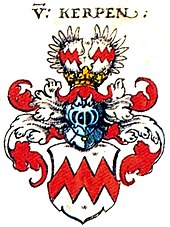Kerpen (noble family)
Kerpen is the name of a Rhineland, probably originally noble free Uradelsgeschlechts that in Kerpen at the Erft with the Burggrafenamt the imperial fortress fief was and with the Reichsministerialen de Warnerus Kerpene 1065-1071 for the first time is mentioned. The sources of the origin of this house are not certain - however, some vague references suggest its descent from a Count of Loon (probably Emmo). Following the sale of of royal estate eventually devolved into possession of the castle and dominion Kerpen on August 2, 1276, the male descendants of the last Reichsministerialen called Kerpen at the Erft only occasionally "Kerpen", but according to their respective new residences " of bushveld "and" von Liblar ". Both are extinct in the male line.
Several genders emerged from the Kerpen family:
- House Wolkenburg , first mentioned in 1125 - extinguished in the middle of the 14th century
- House Merode , first mentioned in 1174
- House Bell , first mentioned in 1183
- House Bergerhausen , first mentioned in 1250 - extinct
- House Dorne, has been documented since the middle of the 13th century - extinct
- House Leutesdorf , has been documented since the second half of the 13th century - expired in 1460
The originally noble ministerial family Kerpen from the Eifel , first mentioned in a document with Sigibertus de Kerpene in 1136 , probably emerged from the older Kerpen an der Erft house and probably gave the castle and the place in the Eifel its name. The genealogical handbook of the nobility begins the safe family line of this house with Heinrich von Kerpena, liber homo (1142–1177), the son of Sigibertus . It extends until 1864 and 1866. The second Grand Master and co-founder of the Teutonic Order Otto von Kerpen , as well as the Knight of the Order of St. John of Jerusalem, Johann Walter von Kerpen, came from this house .
The Burg Kerpen in Illingen in Saarland had Dietrich V of Kerpen in the Eifel in 1359 by the Counts of Saarwerden fief. It was inhabited by the family until 1748. In 1794, Baron Franz Georg von Kerpen lost his sovereignty as sovereign due to the invasion of French revolutionary troops and in 1830 the castle was sold by his daughters after he had died without male descendants.
The Manderscheid rule fell after the male line of the noble free Manderscheid had died out at the beginning of the 13th century through inheritance to the Lords of Kerpen from the Eifel, who now called themselves von Kerpen and Manderscheid . In the middle of the 13th century the property was divided. Theodoric II received Kerpen, Wilhelm (Willekin) II received Manderscheid. In 1461 the Manderscheid line was raised to the rank of imperial count. In 1488 the house was divided into three lines, which were later reunited by inheritance. In 1780 the last of this house, Countess Augusta von Manderscheid-Blankenheim, married the Bohemian Count Philipp Christian von Sternberg. The branch of this family then called itself Sternberg-Manderscheid.
The coat of arms shown here is that of the Kerpen family in the Eifel. The coat of arms of the House of Kerpen an der Erft probably corresponded to that of the House of Merode .
Blazon of the coat of arms of the Lords of Kerpen in the Eifel: a red zigzag bar in silver. On the helmet with red and silver covers a flight marked like the shield.
Individual evidence
- ↑ Severin Corsten: Kerpen in history and present, Kerpen and the Reich, p. 63
- ↑ Hans J. Domsta: History of the Princes of Merode in the Middle Ages, Vol. 1, p. 26
- ↑ Hans Elmar Onnau: Kerpener Heimatblätter Vol. 40 (2002), p. 146
- ↑ Hans J. Domsta: History of the Princes of Merode in the Middle Ages, Vol. 1, p. 29
- ↑ Hans J. Domsta: History of the Princes of Merode in the Middle Ages, Vol. 1, p. 23
- ↑ Hans J. Domsta: History of the Princes of Merode in the Middle Ages, Vol. 1, p. 29
- ↑ Hans Elmar Onnau: Kerpener Heimatblätter Vol. 40 (2002), p. 148
- ↑ Hans J. Domsta: History of the Princes of Merode in the Middle Ages, Vol. 1, p. 30
- ↑ Hans J. Domsta: History of the Princes of Merode in the Middle Ages, Vol. 1, p. 29
- ↑ Rheinische Kunststätten, No. 233, p. 5
- ↑ Hans J. Domsta: History of the Princes of Merode in the Middle Ages, Vol. 1, P. 27, Annexes 19
- ↑ Severin Corsten: Kerpen in history and present, Kerpen and the realm, note 42, p. 66
- ↑ Geneal. Handbook of Adels, Volume 91, Adelslexikon VI, p. 186
- ^ Rheinische Kunststätten: Kerpen (Hohe Eifel) by Herbert Wagner, p. 5
- ↑ Hans J. Domsta: History of the Princes of Merode in the Middle Ages, Vol. 1, p. 29
- ↑ Geneal. Handbook of Adels, Volume 91, Adelslexikon VI, p. 186

